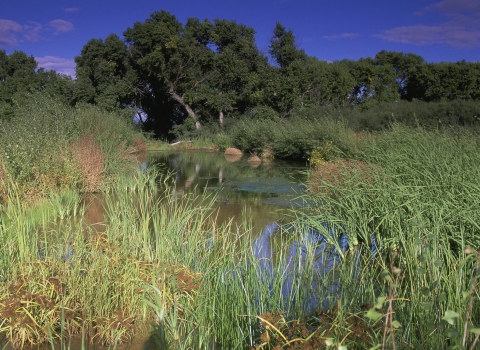Waubay, S.D. – On September 5, the Sisseton-Wahpeton Oyate (SWO) and U.S. Fish & Wildlife Service (Service) celebrated the signing of a Memorandum of Understanding (MOU) between the two governments for the co-stewardship of the Waubay National Wildlife Refuge (Refuge). This historic collaboration between SWO and the Service will increase Tribal involvement in protecting, managing and restoring culturally significant wildlife and plant species, while promoting culturally aware educational opportunities for Tribal members, students, and visitors to the Refuge.
Those who attended – about 75 individuals from the local community and the Service – had an opportunity to take part in the ceremony and witness the signing of the MOU. Several officials from the Service and SWO were in attendance, including SWO Tribal Chairman J. Garret Renville; Vice Chairwoman Alexandria Fancher-Lincoln; SWO Tribal Secretary Curtis Bissonette; Matt Hogan, Regional Director of the Service’s Mountain-Prairie Region; and Cynthia Martinez, Assistant Director of the National Wildlife Refuge System.
“Change only happens when we’re working together,” Chairman Renville said at the ceremony. Darell DeCoteau, Dakotah Cultural Dean of Students of the Enemy Swim Day School, reflected on this historical moment, describing the Refuge as a safe place to heal.
Matt Hogan, Regional Director of the Service’s Mountain-Prairie Region, signed the MOU on behalf of the Service. “We came together to seek a path forward on protecting sacred sites on the Refuge, and we ended up forming a partnership that goes even further than that,” Hogan said. “Today commemorates a momentous effort to unite the conservation efforts of the Service with the Indigenous peoples of this land and reflects a shared vision for conservation, stewardship, and respect to cultural preservation.”
In her opening remarks, Cynthia Martinez, Assistant Director of the National Refuge System, shared that "Indigenous peoples have been connected to this land for thousands of years, and it is only fitting that our conservation efforts align with the Traditional Knowledge of our Indigenous partners and neighbors."
Waubay National Wildlife Refuge is comprised of forest, grassland, and wetland habitats that provide food and cover for more than 245 bird species and other wildlife. Indigenous and Native Americans lived, hunted waterfowl and other game, and gathered edible and medicinal plants here for thousands of years.
“One of the pillars of this MOU is to provide a foundation for the next generations to build upon, and grow an appreciation of the natural world,” Hogan added. “Our children will build upon the legacy of conservation of the natural world that they will inherit.”
Waubay National Wildlife Refuge was established in 1935 as a refuge and breeding ground for migratory birds and other wildlife. The SWO, comprised of the Isanti or Santee Dakota (Sioux) people, called the area that is now Waubay National Wildlife Refuge, “Wabe” (WAH beh) - a waterfowl nesting place. Waterfowl, including ducks and geese, use the small wetlands as breeding habitat and a place to raise their young, while the grasslands provide both food and nesting cover.
For more information, visit the Waubay National Wildlife Refuge website.
The U.S. Fish and Wildlife Service works with others to conserve, protect, and enhance fish, wildlife, plants, and their habitats for the continuing benefit of the American people. For more information, visit www.fws.gov, or connect with us through any of these social media channels: Facebook, X (formerly known as Twitter), Flickr, and YouTube.
